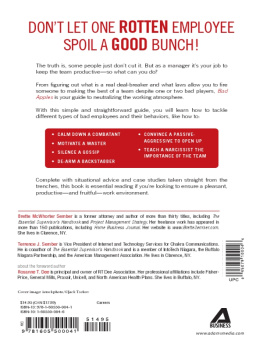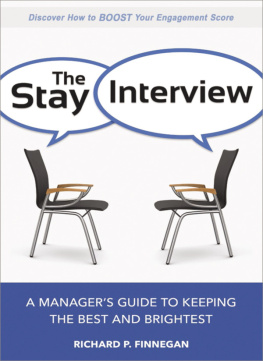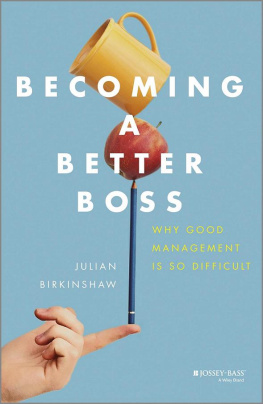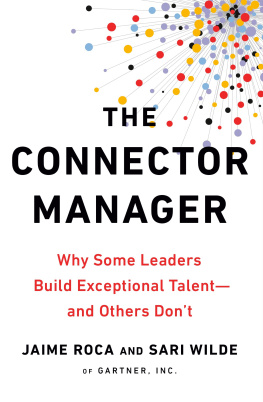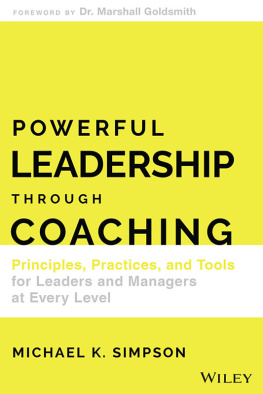BAD APPLES
HOW TO MANAGE DIFFICULT EMPLOYEES,
ENCOURAGE GOOD ONES TO STAY,
AND BOOST PRODUCTIVITY
BRETTE MCWHORTER SEMBER AND TERRENCE J. SEMBER
FOREWORD BY ROSANNE T. DEE

Copyright 2009 by Brette McWhorter Sember and Terrence J. Sember
All rights reserved.
This book, or parts thereof, may not be reproduced in any
form without permission from the publisher; exceptions are
made for brief excerpts used in published reviews.
Published by Adams Business,
an imprint of Adams Media, a division of F+W Media, Inc.
57 Littlefield Street, Avon, MA 02322. U.S.A.
www.adamsmedia.com
ISBN 10: 1-60550-004-6
ISBN 13: 978-1-60550-004-1
eISBN: 978-1-44051-427-2
Printed in the United States of America.
J I H G F E D C B A
Library of Congress Cataloging-in-Publication Data
is available from the publisher.
This publication is designed to provide accurate and authoritative information with regard to the subject matter covered. It is sold with the understanding that the publisher is not engaged in rendering legal, accounting, or other professional advice. If legal advice or other expert assistance is required, the services of a competent professional person should be sought.
From a Declaration of Principles jointly adopted by a Committee of the
American Bar Association and a Committee of Publishers and Associations
Many of the designations used by manufacturers and sellers to distinguish their product are claimed as trademarks. Where those designations appear in this book and Adams Media was aware of a trademark claim, the designations have been printed with initial capital letters.
This book is available at quantity discounts for bulk purchases.
For information, please call 1-800-289-0963.
ACKNOWLEDGMENTS
Our thanks to the many employees we have managed over the years, as well as the managers we have learned from. Many thanks go to our superb agent, Gina Panettieri, for her incredible vision and faith in all of her authors. This book would be sorely lacking were it not for the input of Michael Devlin of Berchem Moses & Devlin in Milford, Connecticut, who lent his employment law expertise. Chelsea King and the entire team at Adams Media have been with us all the way through this project and have been wonderful to work with. Love and thanks to our children, Quinne and Zayne, who would walk by the office and roll their eyes because Mom and Dad were working on the book again.
CONTENTS
PART 1
ABOUT BAD APPLES
CHAPTER 1
WHAT IS A BAD APPLE?
CHAPTER 2
TYPES OF BAD APPLES
CHAPTER 3
BAD APPLES YOU INHERIT
CHAPTER 4
BAD APPLES OUTSID E OF YOUR CONTROL
PART 2
PROBLEM-SOLVING TECHNIQUES
CHAPTER 5
MOTIVATING BAD APPLES TO BECOME GOOD
CHAPTER 6
MAINTAINING GOOD APPLES
CHAPTER 7
DEALING WI TH PERSONALITY CONFLICTS
CHAPTER 8
CULTIVATING CONFLICT RESOLUTION SKILLS
CHAPTER 9
DIS CIPLINING BAD APPLES
CHAPTER 1O
DITCHING BAD APPLES
CHAPTER 11
CONSIDERING LEGAL RAMIFICATIONS
PART 3
FEND OFF FUTURE BAD APPLES
CHAPTER 12
CREATE A POSI TIVE WORK ENVIRONMENT
CHAPTER 13
AVOID HIRING BAD APPLES
CONCLUSION
BALANCING THE APPLE CART
FOREWORD
In todays business environment, where every word is evaluated to ensure political correctness, it was refreshing to read a book that offers sound, practical advice to help you deal with the bad apples in your organization. This book is a must-read for any manager, and its probably a majority of leaders, who has ever had to deal with a bad apple.
As a business consultant, I encounter bad apple behavior in all forms as I help employers and leaders deal with the inevitable fallout. This fallout can be made much easier if you follow the advice of the authors, who offer solutions that blend development and discipline. They point out that the most important test for determining if you have a bad apple is whether or not the person is having a negative impact on the bottom line. They also explain the various types of bad apple behaviors and offer suggestions on how to evaluate whether the source of negative behavior is the person, the environment, or the team. As managers invest a tremendous amount of time and energy in dealing with the issue of bad apple behavior, this book guides them to determine whether they are making a good or bad investment. One bad apple can truly destroy teamwork and morale and, if the leader is reluctant to address the issues, it also can destroy trust in the leader. The authors point out the need for managers to stay in touch with their teams so that they can identify negative behavior early in the game, because some employees show one persona to the boss and treat their peers much differently. If a manager is looking and paying attention to team dynamics he or she may spot a problem before it gets out of control. Suggestions on establishing norms for the team, skill building, and appropriate training are also discussed.
Conflict resolution is one of the key communication skills for leaders, so I would recommend this book to all managers. I would also offer it as a preread to any of the conflict resolution workshops I conduct for leaders. Very specific techniques are spelled out that can serve as a guide to managers.
The importance of identifying the types of people you want to hire and having an effective recruiting and screening process will prevent the hiring of new bad apples. Making sure you make smart hiring decisions will prevent problems that sap energy from the organization. Remember, the leaders responsibility in motivating and directing his or her team sends a message that he or she takes the issue of team behavior seriously. Being clear on expectations is another important aspect of managing behavior.
Finally, the authors upbeat and positive position that it is the leaders responsibility to create a work environment where people can grow and develop communicates an inherent belief that managers control their outcomes. The importance of developing solid, trusting relationships with your people will help determine if an employee will turn into a bad apple.
I love the no-nonsense, take-accountability tone of this book and have learned many new ideas to use in my own business consulting.
Rosanne Dee
Owner of RT Dee and Associates,
a human resource consulting and training firm
August 18, 2008
INTRODUCTION
If management was just about making smart business decisions and being knowledgeable in the industry, many more managers would be successful. However, management is more about people smarts and understanding how to work with, influence, and direct the people who work for you. A large part of people management is learning how to manage bad apples.
A bad apple is one of those employees who is just plain trouble or completely annoying. While its likely that most of your employees do a good job and are reasonably easy to work with, you will, from time to time, come upon someone who is difficult. Bad apples on your team can include anyone from the woman who constantly puts down other people on the team, the guy who is never on time for anything, the woman with the chip on her shoulder, to the man who simply will not stop talking about womens bodies. Occasionally in your career you may have to deal with bad apples with even worse qualitiessomeone who steals from the company or undermines you to your boss. Fortunately these instances are rare. But, in short, a bad apple is the person on your team who makes your life, or those of your other employees, difficult.
Next page
